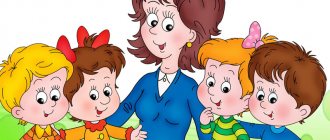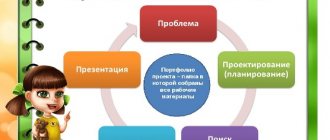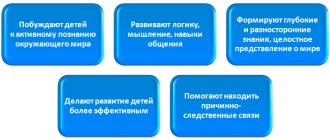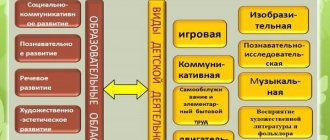Updated July 20, 2022 570 Author: Dmitry Petrov
Hello, dear readers of the KtoNaNovenkogo.ru blog. Every day we work, study, cook lunch, do laundry, do fitness, boxing, embroidery, etc. In other words, we perform some kind of action.
Moreover, the implementation of all of the above does not happen chaotically, but according to a certain algorithm that someone once developed. This algorithm is called technology.
Pedagogy, as the process of educating and training a person, is also based on the use of certain technologies.
Today we’ll talk about what educational technologies are and what types exist.
Pedagogical technology is...
As you already understand, technology is an algorithm (methods and techniques) for performing any actions, pedagogy is the process of upbringing and education.
Consequently, pedagogical technology is a set of methods, forms, methods and techniques intended for the education and training of a person.
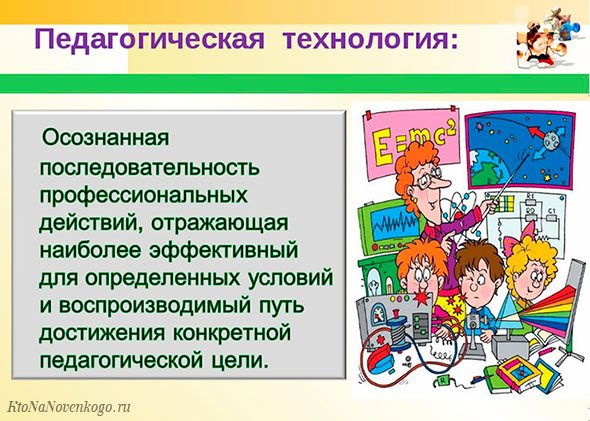
Pedagogical technologies (PT) use specific methodologies, methods and techniques. These concepts are discussed in detail in another article on our blog, so I will not repeat them.
Let me remind you briefly: methodology is a strategy, and methods and techniques are tactics for implementing a strategy.
Pedagogical technologies, regardless of type, are characterized by the following features :
- purposefulness (there cannot be “learning for the sake of learning,” each of the PTs has its own goal);
- scientific validity (implemented PT cannot be applied if it does not have a scientific basis);
- planability (learning cannot be “out of the blue”; PT presupposes the achievement of the planned result);
- efficiency and guaranteed results (if there are no real results, then such a PT has no right to exist);
- comfort for the teacher and student (the learning process should not cause negative emotions).
Bibliography
- Akhmetshin EM, Makulov SI, Talysheva IA, Fedorova SY, Gubarkov S. Overcoming of intercultural barriers in the educational environment // Man in India. – 2022. – T. 97. No. 15. – P. 281-288
- Osadchy EA, Akhmetshin EM Integration of industrial and educational sphere in modernization of economic relations // Journal of Applied Economic Sciences. – 2015. – T. 10. No. 5
- Bayborodova, L.V. General characteristics of technologies of pedagogical activity [Text] / L.V. Bayborodova, I.G. Kharisova, A.P. Chernyavskaya // Modern school management. Head teacher – 2013. – No. 5. – P. 60–78
- Bochkareva, T.N. Cognitive activity of university students as a psychological and pedagogical problem // Modern studies of social problems (electronic scientific journal) / T.N. Bochkareva. – 2017. – T. 8. No. 1. – P. 18-31
- Buzetskaya, T.V. Modern pedagogical technologies in secondary schools [Electronic resource] URL: https://ext.spb.ru/2011-03-29-09-03-14/79-genera-didactic-techniques/4899-2014-03-23- 16-33-40.html
- Vasiliev V.L., Akhmetshin E.M., Ustyuzhina O.N. Competencies of a modern university teacher: challenges of an innovative economy // Pedagogical education in a changing world. Collection of scientific papers of the III International Forum on Teacher Education. – 2017. – pp. 106-115
- Churilov, A.A. Modern teaching technologies in educational institutions / Churilov A.A. - Young scientist. – 2012. – No. 11. – pp. 497– 500
Classification of educational technologies
Differentiation of PT by type depends on the selected classifying feature. Let us consider in the summary table the classification according to the main characteristics:
| Classification sign | Type of pedagogical technology | Explanation |
| content and structure | educational | The learning process provides in-depth knowledge of one or more subjects |
| educational | The main goal is not training, but education | |
| general education | Training is carried out within the framework of the main academic disciplines | |
| form of organization | individual | Education is based on individual communication between teacher and student. Example - tutoring |
| group | A prototype of classroom teaching technology. Initially, students are a group of people of different ages and levels of training. Modern classroom technology assumes that groups of students consist of people of approximately the same level of training | |
| differentiated | A combination of individual and group training | |
| approach to the learner | authoritarian | A student is a subordinate object in the “teacher-student” chain. Characterized by rigid organization of the learning process, suppression of initiative and independence of the student |
| personal | Education is built on the recognition of the student as an individual. The goal is to reveal and increase the student’s potential | |
| cooperative | The basis of the pedagogical process is equal cooperation between teacher and student | |
| predominant teaching method | explanatory and illustrative | Training is carried out on the basis of explanations with simultaneous presentation of visuals |
| reproductive | The essence of learning is “drilling and rote learning” | |
| developing | Training is based on the rapid development of thinking, achieved by the comprehensive development of the student | |
| gaming | The learning process takes place in a game format | |
| problem-search | The teacher sets a problem, students find solutions during a collective discussion |
Each of the existing pedagogical technologies can be classified according to several criteria at once.
For example, PT in secondary schools in our country can be classified (with a few exceptions) as general education, group, authoritarian, explanatory. In principle, this is a classic model of “education for all”, which has confirmed its right to exist with more than 400 years of experience.
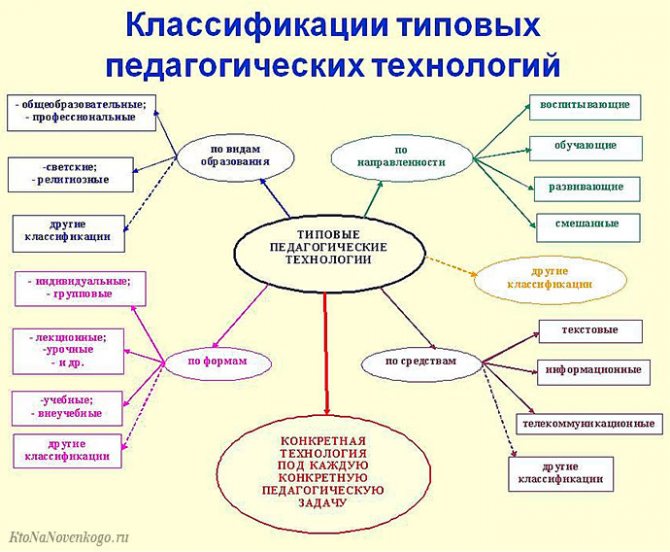
Modern pedagogical technologies use both classical methods and techniques used for centuries, as well as innovative ones (including original ones). The choice of a specific PT is dictated by the circumstances of the current situation or the approved provisions of the educational institution.
I’ll explain with an example: let’s say a child comes to study at a music school. He has wonderful hearing and a magnificent voice. It would seem that practice vocals with him, and do not “torment” the child with other objects.
But the status of a music school implies that the student must receive a full set of knowledge in all musical subjects: in the specialty (learning to play a musical instrument), in solfeggio (hearing development), in choral singing, in musical literature.
This is a unified standard that provides a fairly clear framework for teachers in choosing educational technologies. Based on the completed course of study at a music school, the graduate is issued a state-issued certificate.
If the parents sent the child to study at a music studio for vocals, then he will be taught there mainly in singing. This course is not standardized, so the teacher has complete freedom regarding the choice of pedagogical technology. He can “give” the student a voice using the classical method or use the author’s method.
The use of modern educational technologies in training and education
Svetlana Greshkova
The use of modern educational technologies in training and education
Content:
Chapter 1. Introduction.
1.1. Relevance.
1.2. Challenges of using educational technologies .
Chapter 2. Main part.
2.1. What is educational technology ?
2.2. Basic requirements of pedagogical technology .
2.3. The essence of pedagogical technology .
2.4. The structure of pedagogical technology .
2.5. Types of educational technologies .
2.6. Health-saving technology .
2.7. Technologies of project activities.
2.8. Technology of research activities.
2.9. Information and Communication Technologies .
2.10. Game technology .
Chapter 3. The use of modern educational technologies in working with children older than the preparatory group of MBDOO No. 9 “Thumbelina”
n. New.
3.1. Health-saving technology .
3.2. Technologies of project activities.
3.3. Technology of research activities.
3.4. Information and Communication Technologies .
3.5. Game technology .
Conclusion.
Application.
List of used literature .
Chapter 1. Introduction.
Every year, the science of education introduces increasingly higher requirements for the training and education of the younger generation. One of the main pedagogical tasks is the development and practical application of modern educational technologies that facilitate the learning and upbringing of children .
Therefore, the main task of teachers is to increase the effectiveness of teaching students in accordance with the requirements of the Federal State Educational Standard for Educational Education, to select such means, methods and forms of organizing work with children that optimally correspond to the goal of personal development. Modern pedagogical technologies in preschool education are aimed at improving the quality of children's education , as well as at implementing state standards for preschool education .
1.1. Relevance.
I believe that the use of modern educational technologies in the educational process is relevant , effective and modern . Because children have the opportunity to explore and analyze acquired knowledge, as well as develop creative abilities and communication skills. I think that every teacher should use modern educational technologies in raising children . After all, it is in preschool age that the “foundation”
, which in the future guarantees the successful
education of our children .
1.2. Objectives of using educational technologies :
• increase your level of self-education by mastering modern teaching technologies ;
• apply the acquired knowledge in practice;
• determine the effectiveness of modern pedagogical technologies ;
• improve the quality of education for students .
Chapter 2. Main part.
2.1. What is " technology "
?
Many scientists and teachers studied this concept, such as V. M. Shepel, B. T. Likhachev, V. P. Bespalko, I. P. Volkov, Yu. K. Babansky, N. R. Talyzina, V. F. Shatalov, S. N. Lysenkova. All of them took as a basis the origin of the word “
technology ” from the Greek
“techne”
- art, skill, skills and
“logy”
- science.
Technology is the science of craftsmanship.
Pedagogical technology is an ordered set of actions, operations and procedures that instrumentally ensure the achievement of a predicted result in the changing conditions of the educational process (V. A. Slastenin)
.
2.2. Basic requirements (criteria)
pedagogical
technology :
• Conceptuality
• Consistency
• Controllability
• Efficiency
• Reproducibility.
2.3. The essence of pedagogical technology lies in the fact that it expresses step-by-step stages. Pedagogical technology includes a set of specific professional actions at each stage, allowing the teacher, even in the process of creation, to foresee the intermediate and final results of his own teaching activities. Pedagogical technologies are widely used both in working with children and their parents, and in the teaching staff.
2.4. The structure of pedagogical technology consists of three parts:
Therefore, each technology must meet all of the above requirements.
The interaction of teachers, children and their parents in preschool educational institutions is carried out on the basis of modern educational technologies .
Modern requirements imposed by the state on the quality of educational work in kindergarten imply that the teacher must be a creative person who has a good command of the necessary educational technologies and uses them in working with preschoolers.
2.5. Types of educational technologies .
I, as a teacher who keeps up with the times, use modern educational technologies in my work .
2.6. Health-saving technology .
Goal: to create conditions for students ideas about a healthy lifestyle , the ability to provide first aid to themselves and their neighbors, as well as the formation and development of knowledge, skills and abilities necessary to maintain their own health.
Health-saving pedagogical technologies include all aspects of the teacher’s influence on the child’s health at different levels - informational, psychological, bioenergetic.
In modern conditions, human development is impossible without building a system for the formation of his health.
2.7. Technologies of project activities.
Goal: development and enrichment of social and personal experience through the inclusion of children in the sphere of interpersonal interaction.
Teachers who actively use project technology in the upbringing and teaching of preschoolers unanimously note that life activities organized according to it in kindergarten make it possible to get to know the students and penetrate into the child’s inner world.
Nowadays in the pedagogical environment and in particular in preschool, a lot of attention is paid to design - pedagogical and children's.
Project activities in the educational process are in the nature of cooperation, in which children and preschool teachers take part, and parents and other family members are also involved. Parents can not only be sources of information, real help and support for the child and teacher in the process of working on the project, but also become direct participants in the educational process , enrich their teaching experience, and experience a sense of satisfaction from their successes and the successes of their child.
It is project activity that allows not only to support children's initiative, but also to formalize it in the form of a culturally significant product.
2.8. Technology of research activities.
Goal: systematization of teachers’ knowledge on the development of children’s cognitive and research activities, improvement of pedagogical skills.
Research activity is considered in the educational process as a special type of intellectual and creative activity, generated as a result of the functioning of the mechanisms of search activity and built on the basis of research behavior.
Methods and techniques for organizing experimental research activities:
heuristic conversations;
raising and solving problematic issues;
observations;
modeling (creating models about changes in inanimate nature)
;
experiments;
recording the results: observations, experiences, experiments, work activities;
"immersion"
into the colors, sounds, smells and
images of nature ;
imitation of voices and sounds of nature;
use of artistic words;
didactic games, educational and creative development
situations;
work assignments, actions.
2.9. Information and Communication Technologies .
The world in which a modern child is significantly different from the world in which his parents grew up. This places qualitatively new demands on preschool education as the first link of lifelong education : education using modern information technologies (tablet, computer, interactive whiteboard, etc.)
.
Modern society poses the following tasks to teachers:
to keep up with the times,
become a guide for a child to the world of new technologies ,
mentor in choosing computer programs,
to form the basis of the information culture of his personality,
improve the professional level of teachers and the competence of parents.
Solving these problems is not possible without the use of modern information and communication technologies .
2.10. Gaming technology
Gaming technology is built as a holistic education , covering a certain part of the educational process and united by common content, plot, and character. Gaming technology includes sequentially:
games and exercises that develop the ability to identify the main, characteristic features of objects, compare and contrast them;
groups of games to generalize objects according to certain characteristics;
groups of games, during which preschoolers develop the ability to distinguish real from unreal phenomena;
groups of games that develop the ability to control oneself, speed of reaction to a word, phonemic awareness, ingenuity, etc.
Compiling gaming technologies from individual games and elements is the concern of every educator . Properly selected and well-alternated games and exercises give preschoolers a lot of joyful emotions and develop their dexterity, endurance, coordination of movements, and also help expand children’s motor experience, improve spatial orientation and the ability to act together. Games are selected according to the age of the child, place and time of their implementation.
Learning in the form of a game can and should be interesting, entertaining, but not entertaining. To implement this approach, it is necessary that educational technologies developed for teaching preschoolers contain a clearly defined and step-by-step described system of game tasks and various games so that, using this system , the teacher can be confident that as a result he will receive a guaranteed level of mastery a child of one or another subject content. Of course, this level of achievement of the child must be diagnosed, and the technology used by the teacher must provide this diagnosis with appropriate materials.
In activities with the help of gaming technologies, children develop mental processes.
Gaming technologies are closely related to all aspects of the educational work of a kindergarten and the solution of its main tasks. Some modern educational programs propose using folk games as a means of pedagogical correction of children's behavior.
Thus , modern pedagogical technologies in combination with modern information technologies can significantly increase the efficiency of the educational process and solve the problems facing an educational organization in raising and training developed creative personality.
Chapter 3. The use of modern educational technologies in working with older children – preparatory group of MBDOO No. 9 “Thumbelina”
In my practice, working with children older than the preparatory group, I use the following modern educational technologies :
3.1. I use health-saving in everyday activities, during the working day, in order to preserve and strengthen the health of children. Having set myself the main educational task when interacting with the parents of my students - to develop in children a reasonable attitude towards their body, instill the necessary cultural and hygienic skills, and teach them to lead a healthy lifestyle from childhood . definitely use musical accompaniment.
Thanks to the health-saving direction in my work, the children develop a meaningful attitude towards health as an important life value.
Forms and methods of health-saving technologies include :
— relaxation (exercises to relieve nervous tension in children)
;
General relaxation “Eyes close…”
— health-improving gymnastics and open-air sports equipment for physical development;
- physical education minutes, dynamic pauses; ( "How We Live"
,
“Once we rose”
,
“Leaves”
,
“The wind blows in our faces”,
etc.).
-exercises for eyes, breathing, fingers, etc. ( “Spider”
,
“Gymnastics for the eyes”
,
“Hedgehog”
,
“Blow out the candle”
).
With the help of physical education minutes and finger gymnastics, it is perfectly possible to switch children to another type of activity and increase their performance in educational activities .
I also widely use certain techniques of the described technologies in various forms of organizing the pedagogical process: during educational activities and walks, during restricted moments and in the free activities of children. A mandatory health aspect when working with preschool children is a walk.
Introducing health-saving technologies , I actively use non-standard equipment for:
• self-massage with children (massagers, pencils, prickly balls)
;
My students perform elements of self-massage for themselves and each other, which gives them great joy;
• exercises to strengthen the muscles of the shoulder joint (dumbbells, barbells)
;
• prevention of flat feet
- for emotional warm-ups, which not only relieve emotional stress and set a positive mood, but also develop the strong-willed attention of children.
Emotional warm-up “Sunshine”
Psycho-gymnastics
“Gawkers”
3.2. Technologies of project activities.
A modern teacher must have the knowledge and skills of pedagogical design and organization of children's project activities aimed at transforming the future in the field of upbringing and education of preschool children .
During my work in the senior preparatory group, I developed and implemented the following projects:
— short-term health-saving project “Being healthy is very important!”
.
lifestyle skills in children and their parents.
The project implementation period is from 11/18 to 01/25/15.
The project provided for daily, systematic, preventive health care work with children.
During the project, conversations, classes, excursions, and observations were held.
The result of the project was an exhibition of children's drawings “Sports in my family”
.
- a short-term family project dedicated to the 110th anniversary of the birth of Agnia Barto.
The project implementation period is from 16.02 to 16.03.
The goal of the project: to introduce children to the work of A. L. Barto, to form in them a sustainable interest in the literary word, and to develop creative abilities. During the project, educational conversations were held with children, acquaintance with the work of the poetess, and a book exhibition was organized.
The result of the project was an exhibition of parent-child drawings “The Road to Childhood”
, and the best drawings continued to participate in the regional competition.
At the end of the project, I published an article in the regional newspaper “Red Banner”
“The Everlasting Star”
by Agnia Barto.”
3.3. Technology of research activities.
Research activity is the formation in children of the ability for a research type of thinking. My students are inquisitive children, they strive to learn a lot of new and interesting things. It is this technology that helps children replenish and strengthen their knowledge about the world around them.
Through research activities, working with children 5-7 years old, I use :
- observations
Observation “Lilac in spring”
Observation
“Lizard in the sun”
-Experimental activity
“Spring planting of onions”
“Finding the pulse”
-Work assignments.
3.4. Information and communication technologies .
The information competence of a preschooler represents the foundations, elements of knowledge, skills and value attitudes towards information and information processes that allow the child to engage in the types of information activities available to him: cognitive, play, etc.
In my work I actively use information and communication technologies such as :
• use of the Internet in teaching activities for the purpose of self-education , selection of illustrative material for GCD, conversations, for designing a stand for a developing environment;
• showing presentations;
• musical accompaniment for educational activities, relaxations, physical exercises.
3.5. Gaming technology
Play is the leading activity of a child. In the game he develops as a personality, he develops those aspects of his psyche on which the success of his social practice will subsequently depend. The game creates the basis for a new leading activity - educational. Therefore, the priority task is to optimize and organize a special space in the group to activate, expand and enrich the play activities of pupils . By creating problematic situations in play activities, I encourage children to express their opinions, draw conclusions, and teach them not to be afraid to make mistakes. It is very important that the child gets a taste for receiving new, unexpected information about the objects and phenomena around him.
The specifics of gaming technology are largely determined by the gaming environment: there are games with and without objects, board games, games indoors and outdoors, as well as with various means of transportation; I use in my teaching practice.
-role-playing games ( “Hospital”
,
“Mail”
,
“Family”
,
“Shop”,
etc.)
“Library”
“Family”
“Mail”
“Hospital”
- didactic, board and printed games
Didactic game "The Fourth Wheel"
Board game
"Puzzles"
- outdoor games
In the older preparatory group there is a card index of finger games, theatrical games, movement games, role-playing games, didactic games, and games for the development of emotions.
Conclusion.
Working with children and their parents, I came to the conclusion that the use of modern pedagogical technologies in my professional activities is necessary, because it gives a positive result:
-increases the overall level of mastery of the main educational program of MBDOO No. 9 “Thumbelina”
n. New";
- my students’ social and communication skills are actively developing;
-I note the development of creative, research and analytical thinking in children of senior preschool age;
— there is an interest and involvement of parents in the educational process .
In the future, I plan to continue working on the use of modern educational technologies in the upbringing and education of my students .
I would like to note that all educational technologies are interconnected. And only that technology will give the necessary result, which is inspired by its main author - the Teacher! Every teacher is a creator of technology , even if he deals with borrowings. The creation of technology is impossible without creativity. For a teacher who has learned to work at the technological level , the main guideline will always be the cognitive process in its developing state.
List of used literature .
1. Selevko G.K. Modern pedagogical technologies : textbook. – M.: Public Education , 1998.
2. Atemaskina Yu. V. Bogoslovets L. G. Modern pedagogical technologies in preschool educational institutions. - St. Petersburg: Publishing house "Childhood-Press"
, 2011.
3. Salnikova T. P. Pedagogical technologies : Textbook / M.: TC Sfera, 2005.
4. Veraksa N. E. Project activity of a preschooler: Program library: methods. / N. E. Veraksa, A. N. Veraksa. Mosaic-Synthesis, 2008.
Internet resources:
1. www.koipkro.kostroma.ru;
2. www.maam.ru;
3. www.kirov.spb.ru
